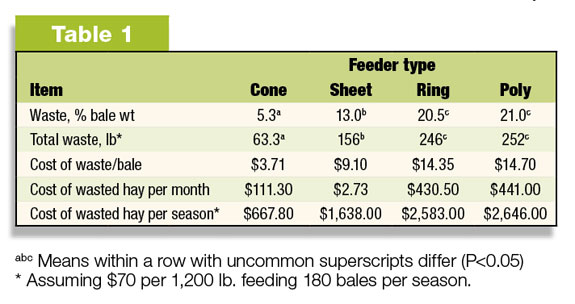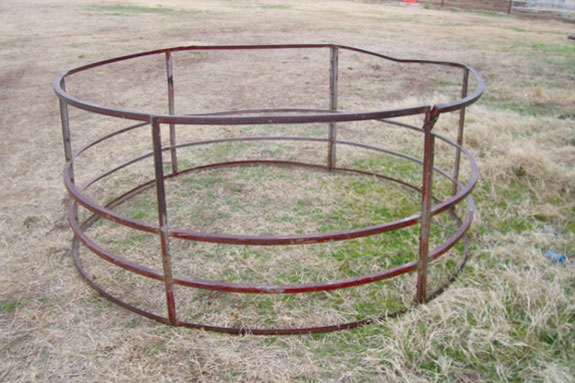The 2011 drought took a severe toll on much of the pastures in Texas, Oklahoma and neighboring states. When hay prices get as high as they were in the spring and summer, you may consider what type of hay feeder to use and how you can save money.
Robert Wells and David Lalman from Oklahoma State University put together a study in late 2011 showing research on which hay feeder design reduced waste and provided savings to producers.
Lalman said four different types of hay feeders were used in the OSU study: a basket-style feeder (BASKET), an open-bottom steel ring (RING), a polyethylene pipe (PIPE) and a sheeted-bottom steel ring (SHEET).
“Twelve cows were in each of the pastures used along with a different hay feeder,” Lalman said. Lalman added that the cows were given a bale in their feeder before the study began, which allowed them to adapt to the feeder.
Lalman said the feeders were stocked based on how many cows were in each pasture. “We figured it would take the 12 cows about four days to consume around 75 percent of each bale added,” Lalman said.
A new bale was added every fourth day, and hay waste would be collected every 24 hours, beginning the fourth day of the second bale added.
“Hay waste was calculated by all of the hay on the outside of the ring,” Lalman said. He added everything that was raked up and collected would be considered waste.
In the study, samples of the hay on the outside of the ring were also taken and examined for moisture, urine contamination and fecal contamination.
Each feeder was also placed on a concrete slab and rotated to a different pasture every two weeks.

Assuming you fed 30 cows 180 bales in a six-month increment, each bale weighing 1,200 pounds at a price of $70 each, your numbers would be similar to what is listed in Table 1.
According to the OSU study, the BASKET feeder would waste $667.80 worth of hay while the SHEET, RING and POLY feeders would waste $1,638, $2,583 and $2,646, respectively.
Trevor Lienemann, of Lienemann Management Production in Princeton, Nebraska, created the basket-style feeder used in this study, which had been referred to as the modified cone feeder or CONE in previous studies.
 “The basket-style feeder I invented kind of changed the way people feed hay or think about hay saving in bale feeders,” Lienemann said.
“The basket-style feeder I invented kind of changed the way people feed hay or think about hay saving in bale feeders,” Lienemann said.
Lienemann said he owns a registered Angus herd and has used hay wagons, standard feeders and, now, the basket-style feeder.
“The basket-style feeder exceeds all of the other feeders from an economic standpoint and hay savings standpoint,” he said.
Lienemann says he sells the basket-style feeders all over the country. A Western distributor told Lienemann the basket-style feeder is their best seller.
Harold Gillenwaters from Chickasha, Oklahoma, has a basket-style feeder. “I have not used it yet, but I am very impressed with the quality and concept.”
Gillenwaters added he is on boards for both the Oklahoma State University and the Noble Foundation and would trust the recommendations from the studies’ results.
Lalman said producers may also have to consider extra costs of machinery operation to go along with the feeders.
“Some feeders are rather heavy and will need a front-end loader to drop the bales into, while some feeders can just be placed over your bale,” he said.
Bob Studebaker, owner of GoBob Pipe and Steel, also sells hay feeders and says producers should be selective in how they pick hay-feeding equipment.
“Some of the feeder inserts that suspend your bales to keep them fresh could be a waste since most ranchers stockpile their bales in windrows and by the time they feed, there may already be a bad side,” he said. ![]()
PHOTOS
Top: The 300-pound, nine feeding station basket feeder (or cone) with the sheeted bottom. This feeder wasted the least amount of hay in the study.
Bottom: Open-bottom steel ring feeder: (ring). The 100-pound, six feeding station open-bottom steel ring feeder. This feeder wasted the second-most hay in the study. Photos courtesy of Oklahoma State University.






